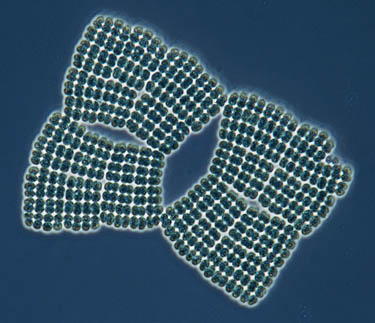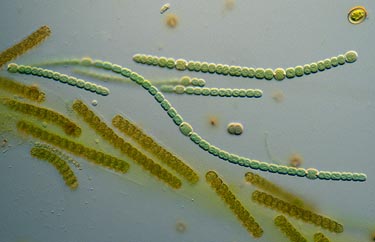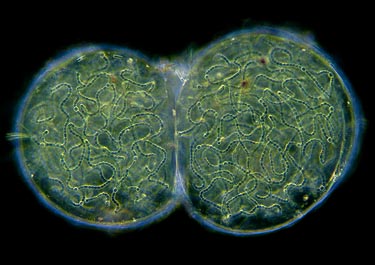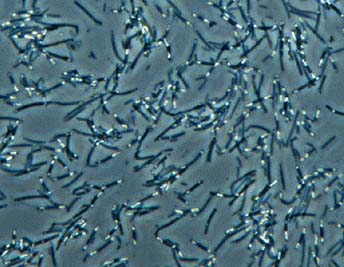| |
BACTERIA by Wim van Egmond |
|
Bacteria are the most ancient life forms Most bacteria are so small that under a light microscope you can only see them as little dots. Some groups however grow to larger sizes and have spectacular shapes. The top picture shows an example of the beauty of one of the more advanced groups of bacteria, the cyanobacteria, or blue green algae. For a long time they were regarded algae since they performed photosynthesis. But they are nowadays regarded bacteria: they lack a membrane bound nucleus. DNA is present in a loop in the cytoplasm. Because they have a very distinct blue green colour a bloom of cyanobacteria is clearly visible when a pond or ditch becomes blue-ish green. | ||
| Bacteria
were the most prominent creatures in the early stages of life's history almost
4000 million years until 600 million years ago. Fossils called stromatolites can
still be found and were made by Cyanobacteria. Cyanobacteria were essential for the developing of more complicated life forms They produced the oxygen in our atmosphere. This oxygen is needed for the much more energy efficient metabolism of mufti cellular organisms. Moreover, the photosynthetic abilities of bacteria were presumably incorporated by the more advanced organisms. At present bacteria have an essential role in the recycling of matter. Bacteria are everywhere. Inside your mouth live more bacteria than the number of people who have ever lived. | 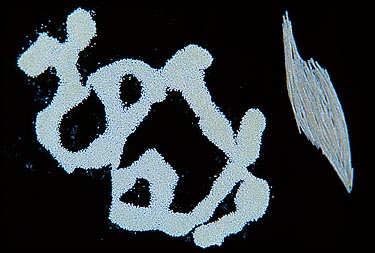 Microcystis flos-aquae (left) and Aphanizomenon flos aqua (right) two common cyanobacteria with interesting shapes that can be found floating under the surface of ponds during summer. | |
The little
animation on the left shows spirochaete bacteria. They are fast movers that have
many flagella that unlike other bacteria lay inside the cell.
Many other bacteria use flagella (whip-like structures) for locomotion. The flagella
of bacteria are quite interesting since they have a simple but very ingenious
design. A bacterial flagellum is a miniature mechanical device with a movement
that is caused by rotation of the shaft, the part where the flagellum is attached
to the cell. It is an extra cellular structure that works like a little propellor. |
| |
| Nostoc is a cyanobacteria that forms large spherical colonies. They are common and can just be seen with the naked eye |
Most bacteria are only visible with the strongest lenses of the microscope. An easy way to collect them (and also many small protists) is by placing a cover slip on the surface of pond water. After a night whole colonies of bacteria will grow on the underside of the cover slip. Carefully placed on a slide (an extra drop of water may be added) the growth under the cover slip can be observed with the 40X or 100 X objective to see the finest details. |
|
